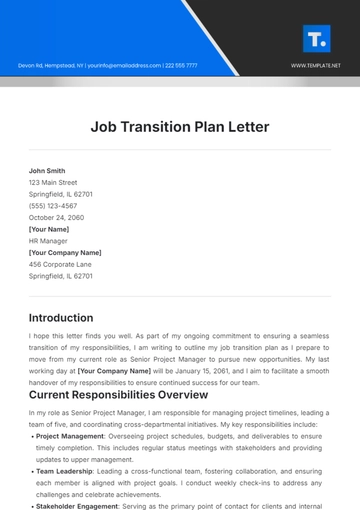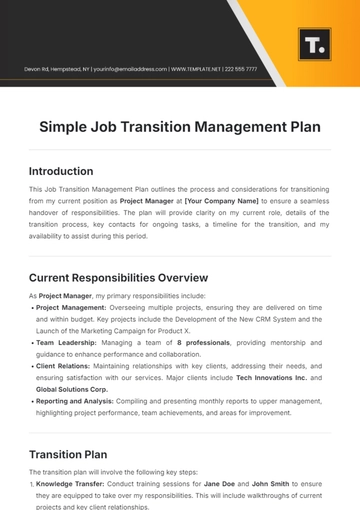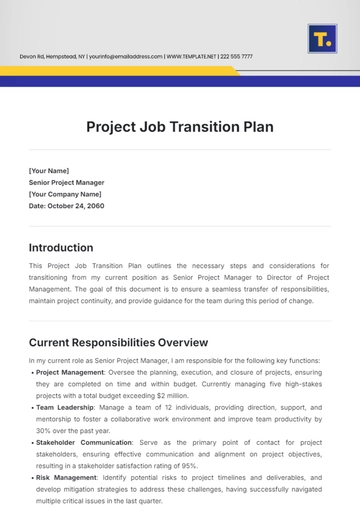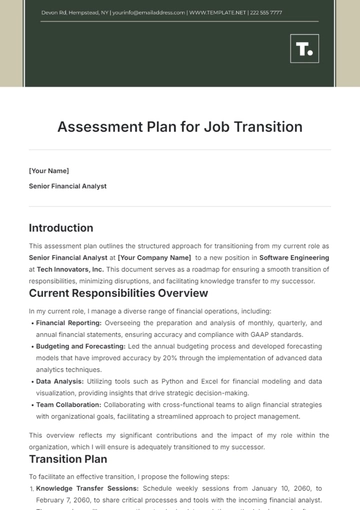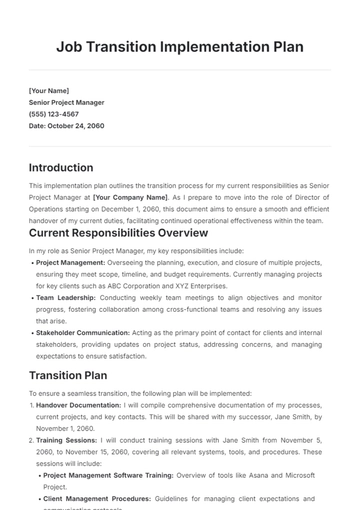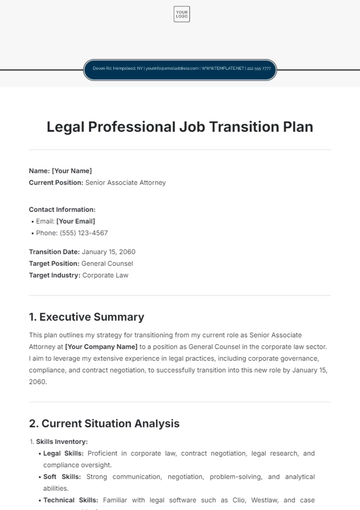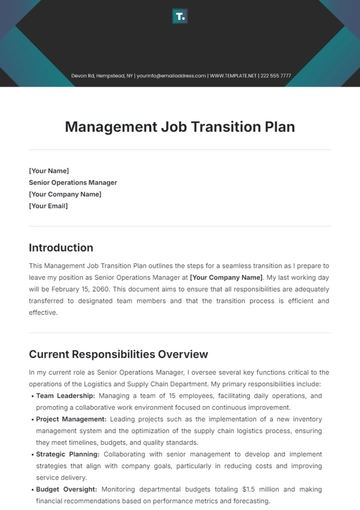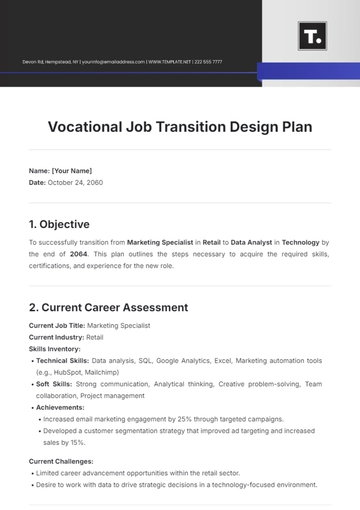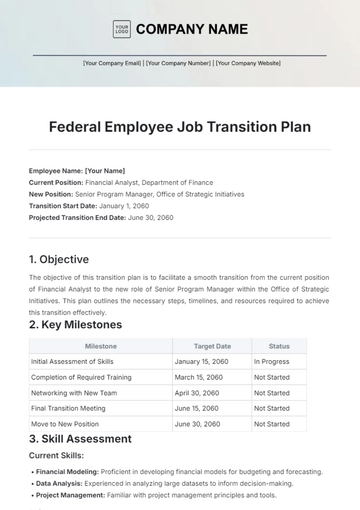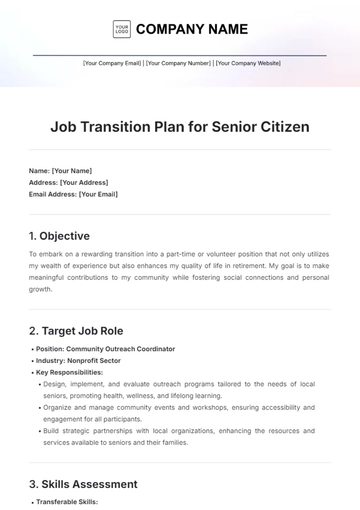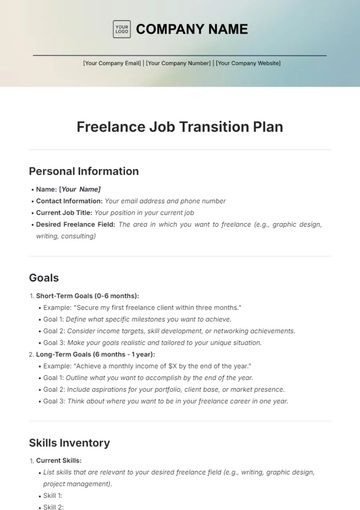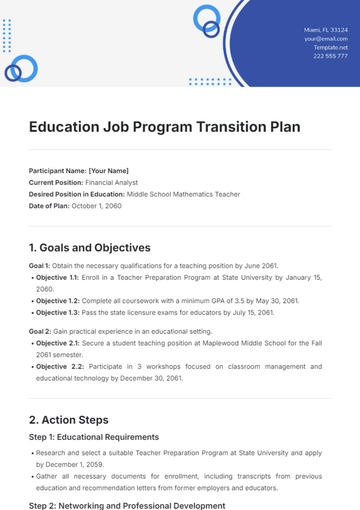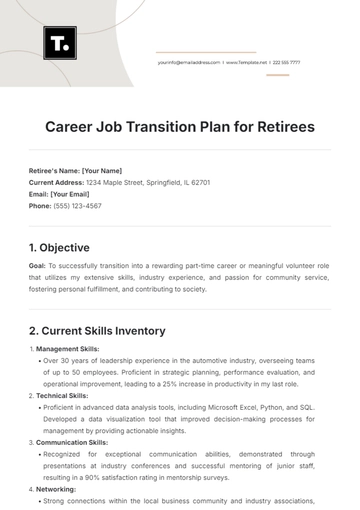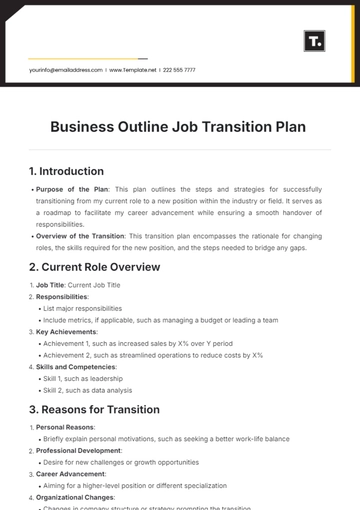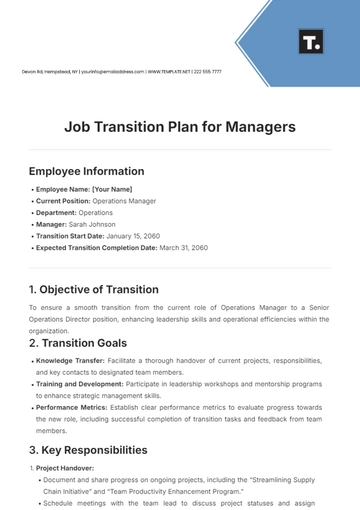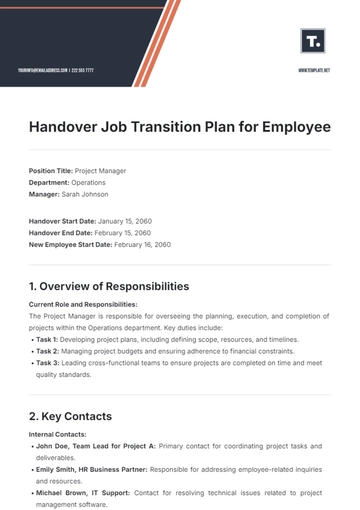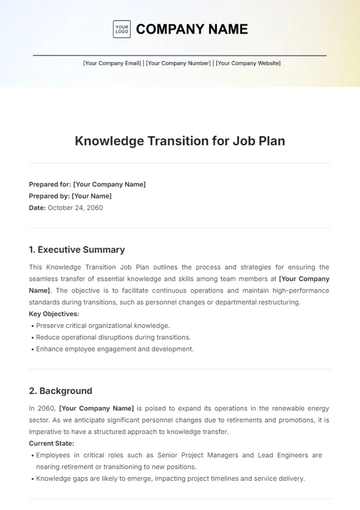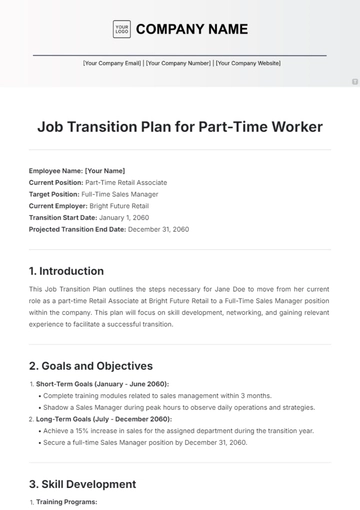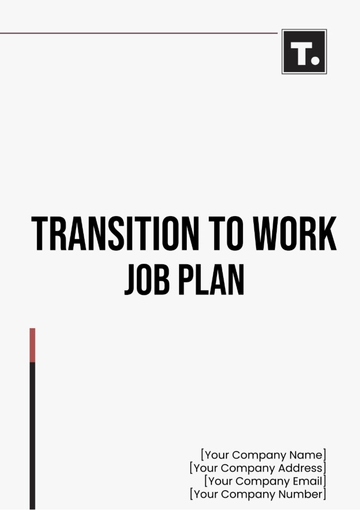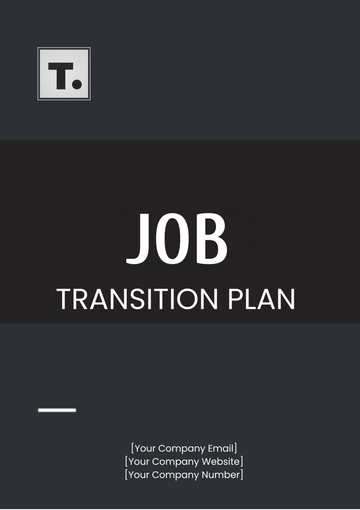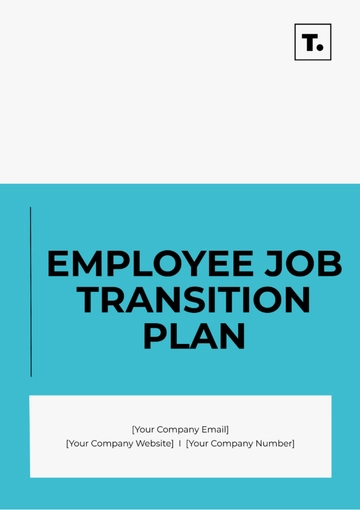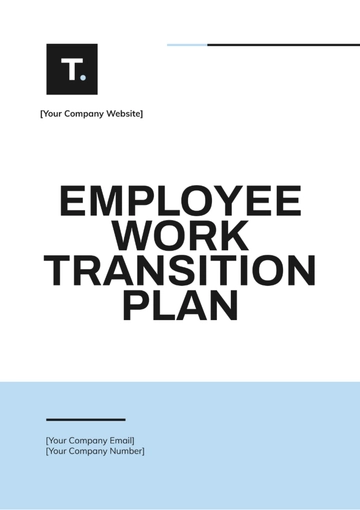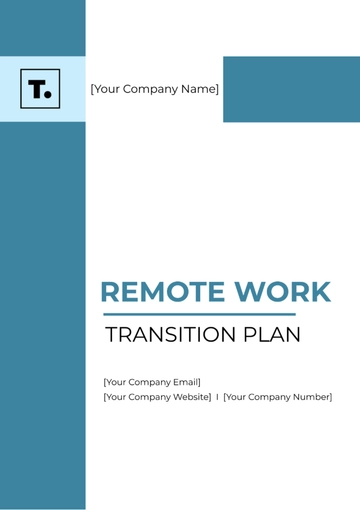Free Blank Freelance Job Transition Plan
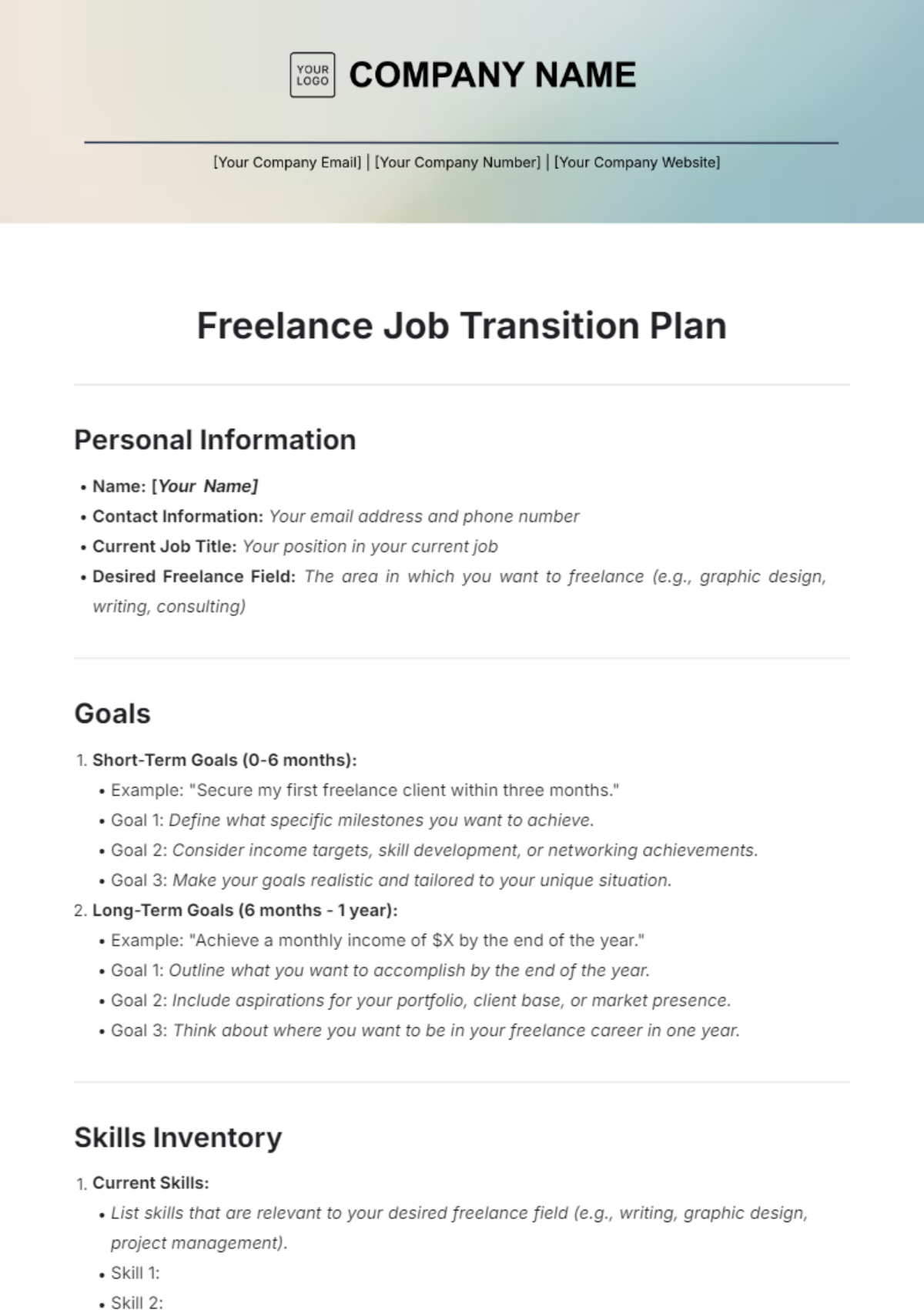
Personal Information
Name: [Your Name]
Contact Information: Your email address and phone number
Current Job Title: Your position in your current job
Desired Freelance Field: The area in which you want to freelance (e.g., graphic design, writing, consulting)
Goals
Short-Term Goals (0-6 months):
Example: "Secure my first freelance client within three months."
Goal 1: Define what specific milestones you want to achieve.
Goal 2: Consider income targets, skill development, or networking achievements.
Goal 3: Make your goals realistic and tailored to your unique situation.
Long-Term Goals (6 months - 1 year):
Example: "Achieve a monthly income of $X by the end of the year."
Goal 1: Outline what you want to accomplish by the end of the year.
Goal 2: Include aspirations for your portfolio, client base, or market presence.
Goal 3: Think about where you want to be in your freelance career in one year.
Skills Inventory
Current Skills:
List skills that are relevant to your desired freelance field (e.g., writing, graphic design, project management).
Skill 1:
Skill 2:
Skill 3:
Skills to Develop:
Identify new skills you need to learn or improve upon to succeed in freelancing.
Skill 1: Consider online courses or workshops that can help you.
Skill 2:
Skill 3:
Market Research
Target Audience/Clients:
Define who your ideal clients are (e.g., startups, small businesses). Consider their demographics and needs.
Audience 1:
Audience 2:
Industry Trends:
Identify trends affecting your freelance field (e.g., increased demand for remote services, specific skills that are in high demand).
Trend 1:
Trend 2:
Competitors:
Identify key competitors in your field and analyze their strengths and weaknesses.
Competitor 1: Consider what they offer and how you can differentiate yourself.
Competitor 2:
Networking Plan
Professional Networks to Join:
List relevant industry associations, forums, or online groups (e.g., LinkedIn groups, industry-specific forums).
Network 1:
Network 2:
Events/Conferences to Attend:
Research industry events, workshops, or conferences that can help you meet potential clients and peers.
Event 1: Consider both in-person and virtual events.
Event 2:
Online Platforms:
Identify platforms where you can showcase your work and connect with clients (e.g., LinkedIn, Upwork, Fiverr).
Platform 1:
Platform 2:
Financial Planning
Current Income vs. Desired Freelance Income:
Current: Document your current monthly income.
Desired: Outline the income you aim to achieve through freelancing.
Budget for Transition:
Outline your expected expenses during the transition (e.g., marketing costs, software subscriptions). Be realistic about your spending.
Item 1: e.g., website hosting
Item 2:
Item 3:
Emergency Fund:
Determine how much money you need to set aside for unexpected expenses during your freelance transition.
Amount: Calculate the total you need for at least 3-6 months of living expenses.
Duration: Decide how long this fund should last if income is low during the transition.
Action Steps
Immediate Actions (within 1 month):
Task 1: Identify one specific action to take right away (e.g., build your portfolio).
Task 2: Consider outreach efforts or joining a professional network.
Task 3:
Mid-Term Actions (1-6 months):
Task 1: Plan for launching your website or social media presence.
Task 2: Set up a client acquisition strategy (e.g., cold pitching).
Task 3:
Ongoing Actions (6 months and beyond):
Task 1: Establish a routine for networking and skill development.
Task 2: Consider continuous learning to stay updated in your field.
Task 3:
Timeline
Create a timeline to visualize your progress and deadlines for each milestone in your transition. This will help keep you accountable.
Milestone | Target Date |
|---|---|
Start Networking | Enter date here |
Complete Skill Development | Enter date here |
First Client Acquisition | Enter date here |
Evaluate Progress | Enter date here |
Reflection and Evaluation
Review Points:
Frequency: Decide how often you will review your progress (weekly, monthly).
Self-Assessment: Consider what metrics you will use to evaluate your success (e.g., number of clients, income).
Client Feedback: Plan to gather feedback from clients to continuously improve your services.
- 100% Customizable, free editor
- Access 1 Million+ Templates, photo’s & graphics
- Download or share as a template
- Click and replace photos, graphics, text, backgrounds
- Resize, crop, AI write & more
- Access advanced editor
Easily navigate your career shift with the Blank Freelance Job Transition Plan Template from Template.net. This editable and customizable template helps you outline your transition strategy, ensuring no detail is overlooked. Tailor it to your unique needs using our Ai Editor Tool for seamless editing. Make your freelance journey smoother today!
You may also like
- Finance Plan
- Construction Plan
- Sales Plan
- Development Plan
- Career Plan
- Budget Plan
- HR Plan
- Education Plan
- Transition Plan
- Work Plan
- Training Plan
- Communication Plan
- Operation Plan
- Health And Safety Plan
- Strategy Plan
- Professional Development Plan
- Advertising Plan
- Risk Management Plan
- Restaurant Plan
- School Plan
- Nursing Home Patient Care Plan
- Nursing Care Plan
- Plan Event
- Startup Plan
- Social Media Plan
- Staffing Plan
- Annual Plan
- Content Plan
- Payment Plan
- Implementation Plan
- Hotel Plan
- Workout Plan
- Accounting Plan
- Campaign Plan
- Essay Plan
- 30 60 90 Day Plan
- Research Plan
- Recruitment Plan
- 90 Day Plan
- Quarterly Plan
- Emergency Plan
- 5 Year Plan
- Gym Plan
- Personal Plan
- IT and Software Plan
- Treatment Plan
- Real Estate Plan
- Law Firm Plan
- Healthcare Plan
- Improvement Plan
- Media Plan
- 5 Year Business Plan
- Learning Plan
- Marketing Campaign Plan
- Travel Agency Plan
- Cleaning Services Plan
- Interior Design Plan
- Performance Plan
- PR Plan
- Birth Plan
- Life Plan
- SEO Plan
- Disaster Recovery Plan
- Continuity Plan
- Launch Plan
- Legal Plan
- Behavior Plan
- Performance Improvement Plan
- Salon Plan
- Security Plan
- Security Management Plan
- Employee Development Plan
- Quality Plan
- Service Improvement Plan
- Growth Plan
- Incident Response Plan
- Basketball Plan
- Emergency Action Plan
- Product Launch Plan
- Spa Plan
- Employee Training Plan
- Data Analysis Plan
- Employee Action Plan
- Territory Plan
- Audit Plan
- Classroom Plan
- Activity Plan
- Parenting Plan
- Care Plan
- Project Execution Plan
- Exercise Plan
- Internship Plan
- Software Development Plan
- Continuous Improvement Plan
- Leave Plan
- 90 Day Sales Plan
- Advertising Agency Plan
- Employee Transition Plan
- Smart Action Plan
- Workplace Safety Plan
- Behavior Change Plan
- Contingency Plan
- Continuity of Operations Plan
- Health Plan
- Quality Control Plan
- Self Plan
- Sports Development Plan
- Change Management Plan
- Ecommerce Plan
- Personal Financial Plan
- Process Improvement Plan
- 30-60-90 Day Sales Plan
- Crisis Management Plan
- Engagement Plan
- Execution Plan
- Pandemic Plan
- Quality Assurance Plan
- Service Continuity Plan
- Agile Project Plan
- Fundraising Plan
- Job Transition Plan
- Asset Maintenance Plan
- Maintenance Plan
- Software Test Plan
- Staff Training and Development Plan
- 3 Year Plan
- Brand Activation Plan
- Release Plan
- Resource Plan
- Risk Mitigation Plan
- Teacher Plan
- 30 60 90 Day Plan for New Manager
- Food Safety Plan
- Food Truck Plan
- Hiring Plan
- Quality Management Plan
- Wellness Plan
- Behavior Intervention Plan
- Bonus Plan
- Investment Plan
- Maternity Leave Plan
- Pandemic Response Plan
- Succession Planning
- Coaching Plan
- Configuration Management Plan
- Remote Work Plan
- Self Care Plan
- Teaching Plan
- 100-Day Plan
- HACCP Plan
- Student Plan
- Sustainability Plan
- 30 60 90 Day Plan for Interview
- Access Plan
- Site Specific Safety Plan
